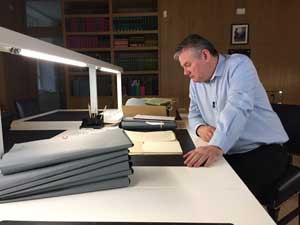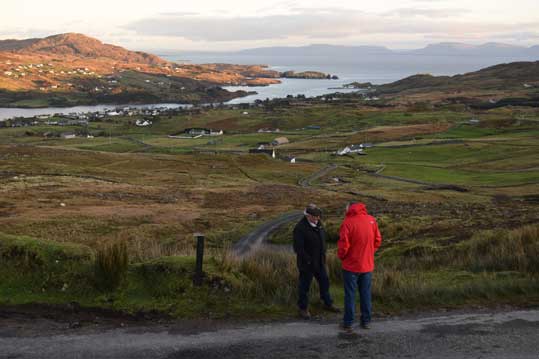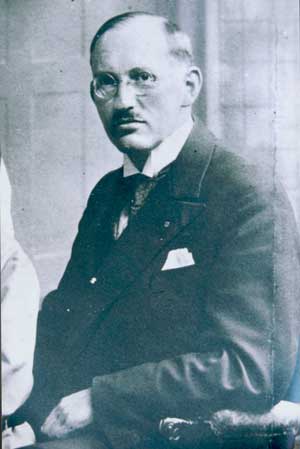Nazi sa Gaeltacht
Published in Issue 5 (September/October 2022), Reviews, Volume 30TG4, 22 June 2022
First broadcast by BBC Northern Ireland, 26 July 2020
Made for BBC Gaeilge by Macha Media
By Sylvie Kleinman
In August 1937, Dr Ludwig Mühlhausen, professor of Celtic studies at Berlin University, arrived in Teileann, a remote Gaeltacht village on the Donegal coast. For six weeks, he improved his Irish, interacted with the locals, and collected folktales. His trip, not the first to Ireland, was well planned as he was well connected: the Folklore Commission directed him to the leading local folklorist, Seán Ó Heochaidh, who found him lodgings with Aodh Ó Beirne, a fisherman. Mühlhausen had asked to stay in a home where Irish was spoken, near the sea and among the people. But some of his habits drew their attention. Made of stern stuff, he was fond of a morning dip, deep into the brisk waters of the open harbour, fed by the mighty Atlantic. Kevin Magee, the investigative journalist who presented this enthralling but also unnerving programme, had himself been going to Teileann for forty years to work on his Irish, and heard stories about the German. Following in Mühlhausen’s footsteps, he would investigate, and find out if the rumours were true. The film was captivating from the outset: the historical implications of this violation of trust were intriguing, and the drone footage from high above, sweeping down and over the magnificent, rugged Donegal coast at Sliabh Liag, was utterly breath-taking. The film, with support from Northern Ireland Screen’s Irish Language Broadcast, logically promoted the quintessentially Irish charms of the region: we followed Magee into a low whitewashed tigín, where he nestled up in front of a roaring turf fire, brandishing a swastikaed document: Mühlhausen had left clues behind. Here was proof that our now nefarious German Gaeilgeoir had, seven years before the outbreak of war in 1939, joined the Nazi party. He had recorded the landscape around Teileann, openly taking innumerable photographs of the pier and harbour on the open sea. He had bathed equipped with a plumb line to measure depths; this was sounding familiar. (For the record, back in 1798, Teileann’s strategic allures already featured on French naval charts; they had sighted it before winds led them south to County Mayo).

Above: Presenter Kevin Magee consulting Army Intelligence files on Mühlhausen in Military Archives in Cathal Brugha Barracks, Dublin. (Macha Media)
Mühlhausen also reported home on Irish attitudes to Nazi Germany. To lively black and white footage of Dev’s bustling and bucolic Ireland, abundant sheep and biretta-ed priests, the latter interacting with women, we learned how German rationalism, aside from its evil intent, had portrayed mindsets. The Irish of a ‘purely ecclesiastical Catholic spirit’, fed daily horror stories of persecution and who blindly believed everything, were contrasted with those who formed their own opinions. We had started with a melodramatic visual jolt to the viewer, a vast Swastika flag flapping in the vigorous Atlantic wind, planted into a Donegal hilltop. Ireland’s greatest threat on the eve of the Second World War had indeed been on the ground: Mühlhausen had infiltrated Teileann and there gathered intelligence. But when we entered the spy’s original bedroom, where he’d settled in very nicely indeed by hanging a portrait of Hitler on the wall, no doubt many a HI reader recalled having heard, or read, the story before. It had been ably demonstrated by David O’Donoghue, and in robustly-researched, scholarly detail: his doctoral thesis (Dublin City University, 1995), was published in 1998 as a book under the same title, Hitler’s Irish Voices; both are freely available. For Mühlhausen had been the first of these voices, broadcasting in Irish from Berlin at the behest of Goebbels’s Ministry of Propaganda. In December 1939, he had started by sending his Teileann friends Christmas greetings over the airwaves; they awoke to bangs on the door. O’Donoghue wove together layers of sources, e.g. the reminiscences of the civil servant (and historian) León Ó Broin. It was he, sharing a room with the spy at Ó Beirne’s in 1937 to perfect his Irish, who recalled the Führer gazing down at him and his roommate singing patriot songs before the morning plunge.

Above: Kevin Magee in conversation with seanchaí Gene Eoghan Ó Curraighín, overlooking Teileann Bay, Co. Donegal. (Macha Media)
Mühlhausen is pictured in O’Donoghue’s, ‘State within a state: the Nazis in neutral Ireland’ (HI 14.6, Nov./Dec. 2006, p.38), in which Ó Broin’s memoir Just like yesterday (1985) was referenced; it also mentions the holiday snaps, which ended up in a German invasion handbook. Much of this material was made good use of in Nazi, but presented in the promotional material as new discoveries. Mühlhausen’s 1932 Nazi membership card is listed in O’Donoghue’s PhD bibliography, as are G2 (Irish Army intelligence) surveillance files on him. They were also onto the infamous National Museum director, Adolf Mahr, who features in the film; Mühlhausen gets a passing mention in the former’s DIB entry. Magee was filmed consulting these files at the Military Archives of Ireland, by ‘special permission’: all researchers in all archival repositories access unpublished documents under this very condition.
O’Donoghue was interviewed and acknowledged in the credits, but what was puzzling was that the film also sidestepped the findings of his own interviews with people who had known Mühlhausen: in Teileann in 1992 he had recorded both Ó Heochaidh and Ó Beirne, since deceased; he then produced a radio programme (1998) broadcasting their testimonials. It seemed a missed opportunity not to weave in these direct and compelling sources of history when filming family members in Teilleann, who could only relay cursory, secondary information about what their relatives may have suspected. But we did get to see the noble ediphone Ó Heochaidh had used for recording. Regardless of how well paced, illustrated, and engaging Nazi sa Gaeltacht was, its hyped claims of telling an ‘untold story’ were only minimally true. The gap between exciting visualised stories of history and their origins, paper sources in scholarly works long in the public domain, could have been more creatively bridged.
Sylvie Kleinman is Visiting Research Fellow at the Dept. of History, Trinity College, Dublin.

















